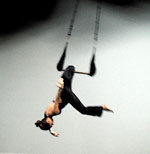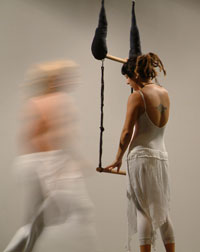


Frequently Asked Questions |
|
How do you rig the trapeze?
Will it work in our Theater? What special requirements do you have? Who does your lighting design and technical work? What do the dancers need? What else do we need to know? If you don't find answers to your questions, please e-mail us! Here is our Technical Requirements listing. Please remember that O-T-O dances on the floor as well as in the air. If trapeze dance is not possible in your facility, let us help you design a modern dance performance that both meets your budget and your highest expectations. How do you rig the trapeze?Rigging Trapeze for use in the Theatre is a highly technical process. Whenever you have humans hanging from ropes, you want to make sure you not only have the best equipment available, but the skills to rig safely and securely. O-T-O uses the best stainless rigging materials and the best rope you can buy. We have many years of experience, and have rigged in theatres from Hermosillio, Mexico to Juneau, Alaska.The exact make-up of the rig depends on the theatre. In a facility with a fly galley, we usually select and secure a series of batons. Batons are secured with a series of aircraft cables and come-a-longs. We call it a "triangular" rig, securing the baton both stage left and right. The idea here is to keep the baton from swinging. Securing the up an down movement also involves the use of aircraft cable and a triangular rig, this time going to the grid. Dead hung facilities are easier obviously, with much less rigging involved. Generally, a series of suitable points over the stage are found to attach the trapeze ropes and associated hardware. Here are some photographs that detail the exact procedure in a proscenium theatre space: Will it work in our Theater?Some theatre spaces have unique challenges, but literally every space can be setup to accommodate the single point trapeze. Flexibility, creativity and safety are the keys in creating an appropriate rig. Any secure attachment points will work, including catwalks and beams. We have a great deal of rigging experience, and travel with everything from beam clamps to bungee cords.What special requirements do you have... ?This depends on the performance agreement. If we work with Trapeze, rigging requirements as outlined above are required. Video projection needs either an adequate cyc or projection screen, plus, (if rear projected) room behind the screen for the projector. Dance floor should be sprung wood, or wood covered with Marly. Outdoor or environmental performances can be on any material, but must be negotiated in advance.Overall, you will find O-T-O Dance very easy to work with. Who does your lighting design and technical work?O-T-O has in-house technical personnel that handle all rigging, lighting design and music. We can send you a light and stage plot for you to hang, or our TD can guide your crew, whichever is more cost effective. Usually, although it depends on the show, we will need you to supply a sound person, light board operator and fly operator. Our stage manager can call the show from on stage or run the light board and call the show.
What do the dancers need?Besides the usual dressing facilities with mirrors, showers and HVAC, the dancers need warm up time, and enough time on stage for blocking and spacing. We can, (depending on the complexity of the concert), move into a theatre in the morning and run a show by 8:PM.Ideally though, (and this again depends on the complexity of the performance), we like a minimum of two days in the theatre. Day one for tech, and day two for dancers. Here in Tucson, we usually have three to four days in the theater for preparation before a show. On tour, where time is tight, we can generally prepare the space in two days, or, with a little planning and a proper crew, one day. When traveling, dancers cannot perform on the same day they travel. This is especially true for long drives or plane flights. Dancers require at least two warm up days before performing while on a tour that has them traveling more than 500 miles from our home studio in Tucson, Arizona.
What else do we need to know?O-T-O is flexible and able to work with presenters in creating performances that suit any situation or community. We like to collaborate with local dancers, musicians and performers (if we have enough time).Remember: O-T-O teaches Trapeze Dance, and it's surprisingly easy to learn. Oh, and yes, it does hurt when you hang by your elbow (a little) O-T-O also teaches Modern Dance, Martial Arts Dance and Aerial Dance for children. Master classes are a good way to include public interaction with the performance. Here is our Technical Requirements listing. |
| Back to Top |